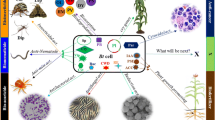Abstract
The presence of synaptonemal complexes were checked in dividing chromosomes as evidence for meiotic division in germinating sporangia. Continuous urografin gradients were used to separate out the various phases of germinating sporangia, the nuclei were removed and embedded for ultrastructural studies. Meiotic inhibitors were applied to germinating sporangia to retard meiotic division to highlight the synaptonemal complexes. At an early phase of sporangial differentiation dividing nuclei developed with synaptonemal complexes. Meiotic inhibitors and stimulators may be used to control sporangial germination for an induction of a high meiospore count. This may be of crucial importance in the utilization ofCoelomomyces spp. as a biological control agent of mosquito species.
Similar content being viewed by others
References
Couch JN, Bland CE. The genusCoelomomyces. eds. Couch JN, Bland CE: Academic Press incorporated, 1985.
Tenci SA, Environmental interactions and their influences on the regulation ofCoelomomyces psorophorae var.tasmaniensis Couch+Laird (1985) infection of mosquito and copepod hosts in nature (Coelomomycetaceae: Blastocladiales). Phd thesis, University of Otago, Dunedin, New Zealand.
Whisler HC, Wilson CM, Travland LB, Olson LW, Borkhards B, Aldrich J, Therrien CD, Zebold SI. Meiosis inCoelomomyces. Exp mycol 1983; 7: 319–327.
Moses MJ. Synaptonemal complex. Ann Rev Genet 1968; 2: 363–412.
Whisler HC, Zebold SL, Shemanchuk JA. Life history ofCoelomomyces psorophorae. Proc nat Acad Sci USA 1975; 72: 693–696.
Olson LW, Eden UM. A glassbead treatment facilitating tje fixation and infiltration of yeast and other refractory cells for electron microscopy. Protoplasm 1977; 91: 417–420.
Reynolds ES. The use of lead citrate at high pH as an electron opaque stain in electron microscopy. J cell Biol 1963; 17: 208–212.
Powell MJ. Ultrastructural changes in the cell surface ofCoelomomyces punctatus infecting mosquito larvae. Can J Bot 1976; 54: 1419–1437.
Powell MJ. Phylogenetic implications of the microbodylipid globule complex in zoosporic fungi. Bio systems 1978; 10: 167–180.
Author information
Authors and Affiliations
Rights and permissions
About this article
Cite this article
Buchanan, F.C., Pillai, J.S. Coelomomyces psorophorae vartasmaniensis Couch+Laird (1988) (Coelomomycetaeceae: Blastocladiales), a fungal pathogen of the mosquitoAedes australis . Mycopathologia 111, 33–37 (1990). https://doi.org/10.1007/BF02277298
Received:
Accepted:
Issue Date:
DOI: https://doi.org/10.1007/BF02277298




